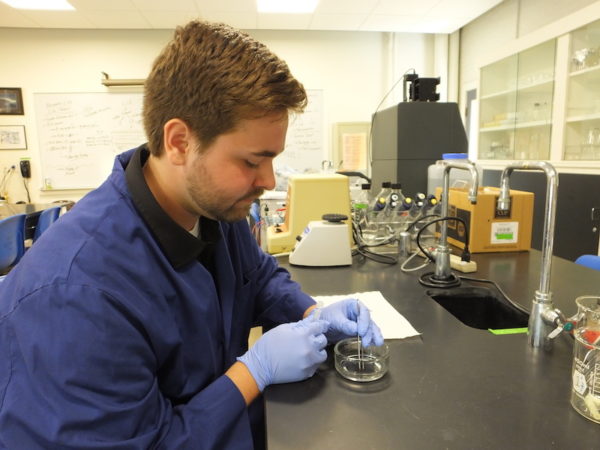 Erick Schadler, a biology major at St. Joseph’s College in Standish, Maine, spent part of his summer break strolling along the power lines by his home in nearby Raymond. These were not leisurely strolls. Erick was hard at work collecting ticks. On purpose.
Erick Schadler, a biology major at St. Joseph’s College in Standish, Maine, spent part of his summer break strolling along the power lines by his home in nearby Raymond. These were not leisurely strolls. Erick was hard at work collecting ticks. On purpose.
He wanted to see how abundant deer ticks were in the area and to classify those he collected by sex and age — how many adults, how many nymphs. He also wanted to test all the ticks to see if they carried bacteria that cause either Lyme Disease or a second tick-borne infection called anaplasmosis.
“I started the project because I knew that some livestock — cattle and horses — and dogs have been getting either Lyme or possibly anaplasmosis,” he told me. “The livestock live near the power lines and it’s where they feed. Humans have been affected, too.”
He made a collection tool called a flag out of a wooden walking stick and a dishtowel. Next, he put on protective clothing, tucked his pants into his socks and doused himself with tick spray. Then he headed out to the power lines, where he dragged the dishtowel along the ground.
He knew the area, which is lush with grass and shrubbery, was an ideal habitat, so he expected to find plenty of ticks. He did and sometimes, even with protection, they were on him, not the dishtowel. “Every every couple of meters I would find one or two on my boots,” he said.” I’d just pick them off and put them in ethanol were I kept them before I did any testing.”
On three separate afternoons, each five days apart, Erick spent two hours dragging for ticks along a 30-meter path. He collected 53 deer ticks. He brought them all to the genetics lab at St. Joseph’s where he conducted biochemical tests to determine their sex and age and whether any were carrying bacteria.
His analysis showed that he’d collected 24 adult females, 21 adult males, and 8 nymphs. He also discovered that 79.2 percent of the ticks carried Borrelia burgdorferi, the bacterium that causes Lyme disease, 30.2 percent carried Anaplasma phagocytophilum, the bacterium that causes anaplasmosis, and 24.5 percent carried both. He didn’t expect to see such high percentages. “I was pretty sure there’d be some indication of both bacteria,” he said, “but definitely not that high.”
Dr. Lucas Bernacki, a biology professor at St. Joseph’s College and Erick’s advisor, believes that his research will help further our understanding of tick-borne illnesses. “It gives us one assessment of the prevalence of the bacterium that is the causative agent of Lyme disease,” he said. “That can give us sort of a baseline to project what the risk is to people in different areas from an ecological perspective.
Erick was able to do his summer project thanks to a grant from the Maine Space Grant Consortium, an affiliate that funds research of interest to NASA through the congressionally established National Space Grant College and Fellowship Program.
Now he’s going to take his research a step further for his capstone project, something many colleges and universities require students to do before they graduate. “Each student has an independent research study that they design, execute, and communicate to the campus community and hopefully beyond,” explained Professor Bernacki.”
At the same time he collected the deer ticks, Erick also got 75 dog ticks. He went back in September to drag for more, but there were none (of either kind). “The next step is to figure out why,” he said. “What is causing their behavior? Does seasonality cause that big of a difference? I kept things consistent where it was the same temperatures between 68 and 74, same weather conditions, same time of day.”
From past research, he wasn’t surprised to see more ticks in late May and early June and fewer in September. He’ll drag again in early November when he expects to see another spike. “And if I don’t,” he said, “I have to explain why.”
Erick isn’t the only St. Joseph’s College student doing field and lab research and he won’t be the last, especially because the college was just awarded a five-year $647,000 grant from the National Science Foundation for its Science Scholars Program. The grant will provide scholarships to students who are committed to studying in a number of scientific fields, including chemistry, biology, environmental science, biochemistry, and marine science.
“This National Science Foundation grant allows us to recruit and graduate some of the best science students from New England and beyond,” said President James Dlugos. “With these funds, we can offer greater access to higher education in the sciences, offer an innovative approach to science career development, and help meet the growing workforce needs in STEM fields.”
Erick will present his final report next spring and then comes graduation. He’s not sure yet if he’ll make a career of scientific research. But if he does, who knows, maybe someday Erick Schadler will get a Nobel Prize in Biology. Just remember where it all started Erick — St. Joseph’s College in your home state of Maine.



Leave A Comment